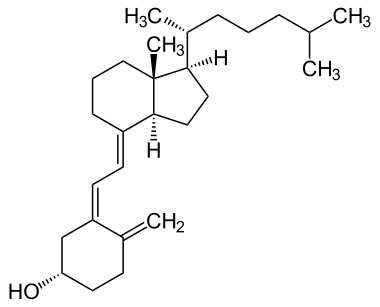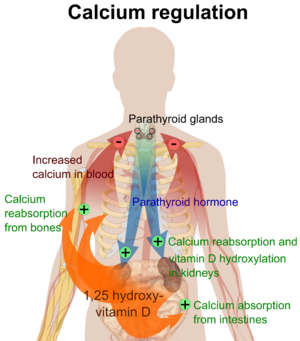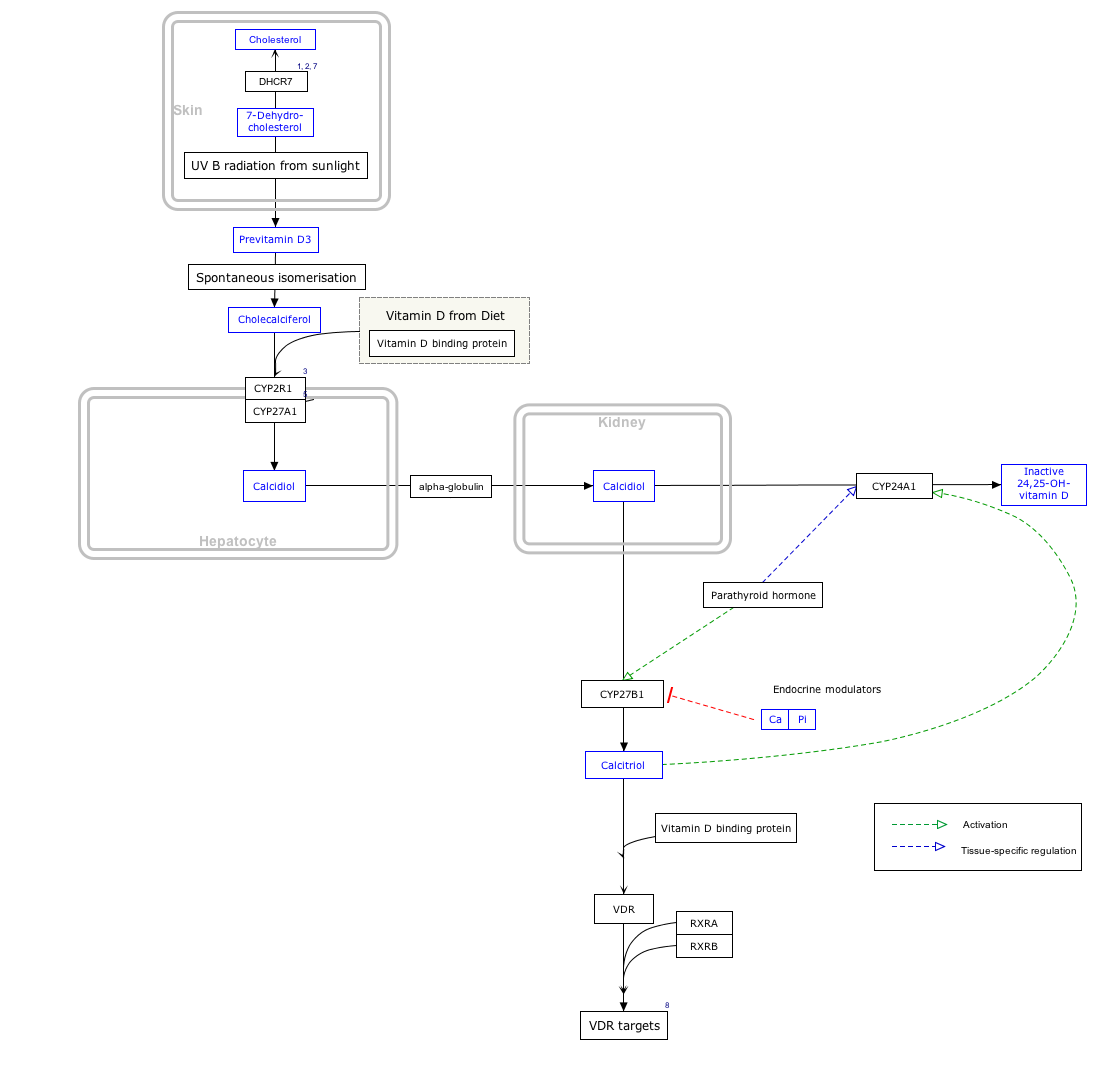Vitamin D/ja: Difference between revisions
Created page with "米国では2016年に食品医薬品局(FDA)が牛乳の栄養強化に関する食品添加物規制を改正し、ビタミンD<sub>3</sub>が乳製品牛乳100{{nbsp}}g(米国クォート当たり400{{nbsp}}IU)当たり42{{nbsp}}IUのビタミンDを超えないこととした、 植物性ミルクでは100{{nbsp}}gあたり84{{nbsp}}IU(1クォートあたり800{{nbsp}}IU)、植物性yo..." Tags: Mobile edit Mobile web edit |
Updating to match new version of source page Tags: Mobile edit Mobile web edit |
||
| (34 intermediate revisions by one other user not shown) | |||
| Line 1: | Line 1: | ||
<languages /> | <languages /> | ||
{{サプリメント}} | |||
{{Pathnav|Dietary supplement/ja|Vitamin/ja|frame=1}} | |||
{{Infobox drug class | {{Infobox drug class | ||
|Synonyms= Calciferols | |Synonyms= Calciferols | ||
| Line 322: | Line 324: | ||
ビタミンDは天然の食品にはわずかしか含まれていないが、製造された食品には[[Food fortification/ja|強化食品]]として一般的に[[food additive/ja|添加]]されている。一部の国では、主食にビタミンDを[[Food fortification/ja|人工強化]]している。 | ビタミンDは天然の食品にはわずかしか含まれていないが、製造された食品には[[Food fortification/ja|強化食品]]として一般的に[[food additive/ja|添加]]されている。一部の国では、主食にビタミンDを[[Food fortification/ja|人工強化]]している。 | ||
==== 天然の供給源 ==== | ==== 天然の供給源 ==== | ||
{{see also/ja|Ergocalciferol/ja#Biosynthesis}} | {{see also/ja|Ergocalciferol/ja#Biosynthesis}} | ||
| Line 399: | Line 400: | ||
|} | |} | ||
一般的に、ビタミンD<sub>3</sub>は[[animal source foods/ja|動物性食品]]、特に魚、肉、[[offal/ja|内臓]]、卵、乳製品に多く含まれる。 | 一般的に、ビタミンD<sub>3</sub>は[[animal source foods/ja|動物性食品]]、特に魚、肉、[[offal/ja|内臓]]、卵、乳製品に多く含まれる。 | ||
ビタミンD<sub>2</sub>は菌類に含まれ、[[ergosterol/ja|エルゴステロール]]の紫外線照射によって生成される。キノコや[[Cladonia/ja|''クラディナ・アルバスキュラ'']という地衣類に含まれるビタミンD<sub>2</sub>含有量は紫外線を浴びることで増加し、強化のために工業用紫外線ランプで刺激される。[[:en:United States Department of Agriculture|米国農務省]]はD<sub>2</sub>とD<sub>3</sub>の含有量を1つの値にまとめて報告している。 | ビタミンD<sub>2</sub>は菌類に含まれ、[[ergosterol/ja|エルゴステロール]]の紫外線照射によって生成される。キノコや[[Cladonia/ja|''クラディナ・アルバスキュラ'']]という地衣類に含まれるビタミンD<sub>2</sub>含有量は紫外線を浴びることで増加し、強化のために工業用紫外線ランプで刺激される。[[:en:United States Department of Agriculture|米国農務省]]はD<sub>2</sub>とD<sub>3</sub>の含有量を1つの値にまとめて報告している。 | ||
==== 食品強化=== | ==== 食品強化=== | ||
| Line 407: | Line 407: | ||
米国では2016年に[[Food and Drug Administration/ja|食品医薬品局]](FDA)が牛乳の栄養強化に関する食品添加物規制を改正し、ビタミンD<sub>3</sub>が乳製品牛乳100{{nbsp}}g(米国[[:en:quart|クォート]]当たり400{{nbsp}}IU)当たり42{{nbsp}}IUのビタミンDを超えないこととした、 [[plant milk/ja|植物性ミルク]]では100{{nbsp}}gあたり84{{nbsp}}IU(1クォートあたり800{{nbsp}}IU)、植物性[[yogurt/ja|ヨーグルト]]または大豆飲料製品では100{{nbsp}}gあたり89{{nbsp}}IU(1クォートあたり800{{nbsp}}IU)である。植物性ミルクとは、大豆、アーモンド、米、その他の植物源から作られた飲料のうち、乳製品の代替品として意図されたものを指す。 | 米国では2016年に[[Food and Drug Administration/ja|食品医薬品局]](FDA)が牛乳の栄養強化に関する食品添加物規制を改正し、ビタミンD<sub>3</sub>が乳製品牛乳100{{nbsp}}g(米国[[:en:quart|クォート]]当たり400{{nbsp}}IU)当たり42{{nbsp}}IUのビタミンDを超えないこととした、 [[plant milk/ja|植物性ミルク]]では100{{nbsp}}gあたり84{{nbsp}}IU(1クォートあたり800{{nbsp}}IU)、植物性[[yogurt/ja|ヨーグルト]]または大豆飲料製品では100{{nbsp}}gあたり89{{nbsp}}IU(1クォートあたり800{{nbsp}}IU)である。植物性ミルクとは、大豆、アーモンド、米、その他の植物源から作られた飲料のうち、乳製品の代替品として意図されたものを指す。 | ||
ビタミンD<sub>3</sub>は25(OH)Dの血中濃度をより早く上昇させ、体内でより長く活性を保つという研究もあるが、ビタミンD<sub>2</sub>の供給源は25(OH)Dを上昇させ持続させるためにD<sub>3</sub>と同様に生物学的利用能があり効果的であるという意見もある。 | |||
=== 食品の調理 === | |||
=== | 一般的な食品のビタミンD含量は、調理によってさまざまに減少する。茹でたり、揚げたり、焼いたりした食品は、ビタミンDの89%を保持している。 | ||
== 推奨血清レベル == | |||
{{Anchor|Recommended serum levels}} | |||
{{See also|Reference ranges for blood tests#Vitamins|Hypervitaminosis D#Ethnic differences}} | {{See also/ja|Reference ranges for blood tests/ja#Vitamins|Hypervitaminosis D/ja#Ethnic differences}} | ||
[[File:Vitamin D serum levels in adults world map.svg|thumb|upright=1.35| | [[File:Vitamin D serum levels in adults world map.svg|thumb|upright=1.35|世界の成人のビタミンD血清レベル(nmol/L)。{{legend|green|> 75}}{{legend|yellow|50-74}}{{legend|orange|25-49}}]] | ||
推奨される25(OH)D血清レベルに関する勧告は、当局によって異なり、年齢などの要因によっても異なる。米国の研究所では一般的に25(OH)D値をng/mLで報告している。他の国ではnmol/Lを用いることが多い。1{{nbsp}}ng/mLは2.5{{nbsp}}nmol/Lにほぼ等しい。 | |||
2014年のレビューでは、25(OH)Dがすべての転帰に最も有利な血清レベルは30{{nbsp}}ng/mL(75{{nbsp}}nmol/L)に近いようだと結論づけている。最適なビタミンD濃度はまだ議論の余地があり、別のレビューでは、30~40{{nbsp}}ng/mL(75~100{{nbsp}}nmol/L)の範囲がアスリートに推奨されると結論している。論争の一因は、多くの研究で25(OH)Dの血清レベルに民族間の差があることがわかったからである。これらの差の背景には、環境的な理由だけでなく、遺伝的な理由も指摘されている。これらの基準値を達成するためにサプリメントを摂取すると、有害な血管の[[calcification/ja|石灰化]]を引き起こす可能性がある。 | |||
2012年の[[meta-analysis/ja|メタアナリシス]]では、ビタミンDの血中濃度が8~24{{nbsp}}ng/mL(20~60{{nbsp}}nmol/L)の範囲で最も低いときに[[心血管系疾患]]のリスクが上昇することが示されたが、分析した研究間の結果は一貫していなかった。 | |||
2011年、[[:en:Institute of Medicine|IOM]]委員会は、骨と全身の健康のためには20{{nbsp}}ng/mL(50{{nbsp}}nmol/L)の血清25(OH)Dレベルが必要であると結論づけた。ビタミンDの食事摂取基準値は、安全性に余裕を持たせ、目標とする血清値を「オーバーシュート」して選ばれており、指定されたレベルの摂取量で、ほぼすべての人が望ましい血清25(OH)D値を達成できるようになっている。血清25(OH)D値には日光暴露による寄与は想定されておらず、推奨値は[[:en:dark skin|浅黒い肌]]の人や日光暴露がごくわずかな人にも完全に適用される。研究所は、血清25(OH)D濃度が30{{nbsp}}ng/mL (75{{nbsp}}nmol/L)以上では「一貫して有益性の増加とは関連しない」とした。血清25(OH)D濃度が50{{nbsp}}ng/mL (125{{nbsp}}nmol/L)を超えると、心配の種になるかもしれない。しかし、血清25(OH)Dが30~50{{nbsp}}ng/mL(75{{nbsp}}nmol/L~125{{nbsp}}nmol/L)の人の中にもビタミンDが不十分な人がいる。 | |||
== 過剰 == | |||
{{Anchor|Excess}} | |||
{{further|hypervitaminosis D}} | {{further/ja|hypervitaminosis D/ja}} | ||
ビタミンD中毒はまれである。日光ではなく、高用量のビタミンDを補給することによって引き起こされる。ビタミンD毒性の閾値は確立されていない; しかし、いくつかの研究によると、耐容上限摂取量(UL)は9~71歳で4,000[[:en:International unit|IU]]/日(100{{nbsp}}μg/日)である、 50,000{{nbsp}}IU/日(1250{{nbsp}}μg)以上の持続的摂取は、数ヵ月後に明らかな[[toxicity/ja|毒性]]を生じ、血清25-ヒドロキシビタミンD濃度を150{{nbsp}}ng/mL以上まで上昇させる可能性がある。原発性[[hyperparathyroidism/ja|副甲状腺機能亢進症]]などの特定の病状のある人はビタミンDに対してはるかに感受性が高く、ビタミンD栄養の増加に反応して[[hypercalcemia/ja|高カルシウム血症]]を発症する。妊娠中の母親の高カルシウム血症はビタミンDの影響に対する胎児の感受性を高め、知的障害や顔面奇形の症候群を引き起こす可能性がある。 | |||
特発性乳児高カルシウム血症は、[[CYP24A1/ja|CYP24A1]]遺伝子の変異によって引き起こされ、ビタミンDの分解が低下する。このような変異を有する乳児は、ビタミンDに対する感受性が亢進し、追加摂取した場合には[[hypercalcaemia/ja|高カルシウム血症]]の危険性がある。この障害は成人期まで続くことがある。 | |||
2015年に発表されたレビューでは、副作用が報告されているのは25(OH)Dの血清濃度が200{{nbsp}}nmol/Lを超えた場合のみであると指摘されている。 | |||
ビタミンDの投与量と25-ヒドロキシ-ビタミンD濃度が判明している高カルシウム血症を伴う毒性の発表例は、いずれも1日あたり40,000{{nbsp}}IU(1,000{{nbsp}}μg)以上の摂取である。 | |||
妊娠中または授乳中の人は、ビタミンDサプリメントを摂取する前に医師に相談すべきである。FDAは、液体ビタミンDサプリメントの製造業者に対し、これらの製品に添付するスポイトには400[[国際単位]]分(1{{nbsp}}IUはコレカルシフェロール/エルゴカルシフェロール25{{nbsp}}ngの生物学的等価量)を明確かつ正確に表示するよう助言した。さらに、乳児を対象とした製品について、FDAはスポイトの保持量が400{{nbsp}}IUを超えないことを推奨している。乳児(出生から12ヵ月)については、耐容上限量(害なく耐えられる最大量)が25{{nbsp}}μg/日(1,000{{nbsp}}IU)に設定されている。乳児の場合、1日1000マイクログラムで1ヶ月以内に毒性が現れた。カナダ政府とアメリカ政府の委託を受けた[[:en:Institute of Medicine|医学研究所]](IOM){{as of|2010|11|30|lc=y}} は、耐容上限値(UL)を1~3歳は1日2,500{{nbsp}}IU、4~8歳は1日3,000{{nbsp}}IU、9~71歳以上(妊娠中または授乳中の女性を含む)は1日4,000{{nbsp}}IUに引き上げた。 | |||
カルシトリオール自体は、[[negative feedback/ja|負のフィードバック]]サイクルで自動調節されており、[[parathyroid hormone/ja|副甲状腺ホルモン]]、[[fibroblast growth factor 23/ja|線維芽細胞増殖因子23]]、[[cytokine/ja|サイトカイン]]、カルシウム、リン酸塩によっても影響を受ける。 | |||
2017年に発表された研究では、1999年から2014年までの公開されている[[NHANES/ja|NHANES]]データに基づいて、米国の20歳以上の成人におけるサプリメント・ビタミンDの1日摂取レベルの高さの有病率を評価した。そのデータは以下のことを示している: | |||
* 人口の18%以上が、[[National Institutes of Health/ja|NIH]]の1日の推奨摂取量([[Recommended Daily Allowance/ja|RDA]])である600-800 IUを超え、1000 IU以上を摂取しており、意図的なサプリメント摂取を示唆している。 | |||
* | * 人口の3%以上が、NIHの1日耐容上限摂取量レベル([[Tolerable upper intake level/ja|UL]])の4000IUを超えている。 | ||
* | * 傾向分析によると、1000IU/日以上摂取している人の割合も、4000IU/日以上摂取している人の割合も、1999年以降増加している。 | ||
* | |||
=== 過剰摂取の影響 === | |||
ビタミンDの過剰摂取は高カルシウム血症を引き起こし、これはビタミンD中毒の強い徴候である-これは排尿および口渇の増加で指摘できる。高カルシウム血症を治療しないと、軟部組織および腎臓、肝臓、心臓などの臓器にカルシウムが過剰に沈着し、疼痛および臓器障害を来す。 | |||
ビタミンD過剰摂取の主な症状は、[[Anorexia (symptom)/ja|食欲不振]]、吐き気、嘔吐を含む高カルシウム血症である。これらに続いて、[[polyuria/ja|多尿]]、[[polydipsia/ja|多飲]]、脱力感、不眠、神経過敏、[[pruritus/ja|そう痒症]]、最終的には腎不全が起こる。さらに、[[proteinuria/ja|蛋白尿]]、[[urinary casts/ja|尿ギプス]]、[[azotemia/ja|無力血症]]、[[metastatic calcification/ja|転移性石灰化]](特に腎臓)が発現することがある。ビタミンD中毒の他の症状としては、幼児における知的障害、骨の成長・形成異常、下痢、過敏症、体重減少、重度のうつ病などがある。 | |||
ビタミンD中毒の治療には、ビタミンDの補給を中止し、カルシウムの摂取を制限する。腎臓の障害は不可逆的である。通常、日光を長時間浴びてもビタミンD中毒は起こらない。皮膚で産生されたビタミンD前駆体の濃度は[[Chemical equilibrium/ja|均衡]]に達し、それ以上産生されたビタミンDは分解される。 | |||
== 生合成 == | |||
{{Anchor|Biosynthesis}} | |||
自然界におけるビタミンDの合成は、紫外線の存在とそれに続く肝臓および腎臓での活性化に依存している。多くの動物は[[7-dehydrocholesterol/ja|7-デヒドロコレステロール]]からビタミンD<sub>3</sub>を合成し、多くの菌類は[[ergosterol/ja|エルゴステロール]]からビタミンD<sub>2</sub>を合成する。 | |||
</ | |||
===インタラクティブな経路=== | |||
右下のアイコンをクリックして開く。 | |||
{{VitaminDSynthesis_WP1531|highlight=Calcifediol|align=left}} | {{VitaminDSynthesis_WP1531|highlight=Calcifediol|align=left}} | ||
=== 光化学 === | |||
=== | [[File:Vitamin D biosynthesis in fungi and animals.svg|thumb|upright=1.35|動物および菌類におけるビタミンD生合成の光化学]] | ||
[[File:Vitamin D biosynthesis in fungi and animals.svg|thumb|upright=1.35| | [[File:Calcitriol-Biosynthese 2.svg|thumb|upright=1.35|ビタミンD<sub>3</sub>への[[previtamin D3/ja|プレビタミン{{nbsp}}D<sub>3</sub>]]の熱異性化反応]] | ||
[[File:Calcitriol-Biosynthese 2.svg|thumb|upright=1.35| | 7-デヒドロコレステロールをビタミンD<sub>3</sub>に変換する変換は2つのステップで起こる。第一に、7-デヒドロコレステロールは紫外線によって6電子の[[conrotatory/ja|共役]]開環[[electrocyclic reaction/ja|電気環式反応]]で[[photolysis/ja|光分解]]され、生成物は[[previtamin D3/ja|プレビタミン{{nbsp}}D<sub>3</sub>]]である。 | ||
第二に、プレビタミン{{nbsp}}D<sub>3</sub>は自発的にビタミン{{nbsp}}D<sub>3</sub>([[cholecalciferol/ja|コレカルシフェロール]])に[[isomer/ja|異性体]]化して、[[antarafacial/ja|アンタラフェイシャル]]な[[Sigmatropic shift/ja#.5B1,7.5D Shifts|シグマトロピック[1,7]水素化物シフト]]により変換される。 | |||
室温では、有機溶媒中でプレビタミン{{nbsp}}D<sub>3</sub>からビタミンD<sub>3</sub>への変換は約12日で完了する。 | |||
皮膚におけるプレビタミン{{nbsp}}D<sub>3</sub>からビタミンD<sub>3</sub>への変換は、有機溶媒中よりも約10倍速い。 | |||
エルゴステロールからビタミンD<sub>2</sub>への変換も同様の手順で行われ、光分解によってプレビタミン{{nbsp}}D<sub>2</sub>が形成され、これが異性化してビタミンD<sub>2</sub>([[ergocalciferol/ja|エルゴカルシフェロール]])となる。メタノール中でのプレビタミン{{nbsp}}D<sub>2</sub>からビタミンD<sub>2</sub>への変換は、プレビタミン{{nbsp}}D<sub>3</sub>と同程度の速度である。このプロセスはホワイトボタンマッシュルームではより速い。 | |||
=== 皮膚での合成 === | |||
=== | [[File:Skinlayers.png|thumb|皮膚の表皮層では、ビタミンDの産生は基底層(図では赤色)と有棘層(薄茶色)で最も多い。]] | ||
[[File:Skinlayers.png|thumb| | ビタミンD<sub>3</sub>は、ヒトを含むほとんどの脊椎動物の皮膚で7-デヒドロコレステロールから光化学的に生成される。ビタミンD<sub>3</sub>の前駆体である7-デヒドロコレステロールは比較的大量に生産される。 | ||
7-デヒドロコレステロールは290-315 nmの[[:en:wavelengths|波長]]の[[:en:Ultraviolet light#Subtypes|UVB光]]と反応する。 | |||
これらの波長は、太陽光や[[:en:tanning bed|日焼けベッド]]のUVランプ(主に[[:en:Ultraviolet light#Subtypes|UVA]]スペクトルの紫外線を発生する、 | |||
しかし、一般的にUVBとして全紫外線放射量の4%から10%を生成するため、ビタミンD生成のために特別にUVBのみを使用できる日焼けベッドもある)。 | |||
ガラスはUVB光をほぼ完全に遮断するため、窓から光を浴びるのは不十分である。 | |||
十分な量のビタミンDは、顔、腕、脚(メラニンが最も少ない人の場合)に、週に2回、平均5~30分、または日焼けを最小限に抑えるために約25%、適度に日光を浴びることで生成することができる。肌の色が[[:en:Fitzpatrick scale|フィッツパトリック・スケール]]で濃く、日差しが弱ければ弱いほど、何分も浴びる必要がある。この3つの要素はすべて最小紅斑量(MED)に影響する。紫外線暴露によるビタミンDの過剰摂取は不可能である:皮膚はビタミンDが生成されると同時に分解される平衡状態に達する。 | |||
皮膚は、[[:en:dermis|真皮]]と呼ばれる内側の層と、外側のより薄い[[epidermis (skin)/ja|表皮]]の2つの主要な層から構成されている。ビタミンDは、表皮の最も内側にある基底層と有棘層という2つの層の[[keratinocytes/ja¥ケラチノサイト]]で産生される。 | |||
=== 進化 === | |||
== | ビタミンDは光化学プロセスによってのみ合成される。[[sterol/ja|ステロール]]からの生成は[[:en:origin of photosynthesis|光合成の起源]]の頃に生命の進化のごく初期に始まったと考えられ、おそらくUVBを吸収してDNAの損傷を防ぐのに役立ち、ビタミンDは不活性な最終生成物となった。[[vitamin D receptor/ja|ビタミンD受容体]](VDR)、活性化と不活性化のための様々な[[CYP450/ja|CYP450]]酵素、ビタミンD結合タンパク質(DBP)を含むおなじみのビタミンD内分泌機構は[[vertebrate/ja|脊椎動物]]だけに見られる。原始的な海洋脊椎動物は、海洋からカルシウムを骨格に吸収し、ビタミンDを豊富に含むプランクトンを食べていると考えられているが、石灰化軟骨を持たない脊椎動物の機能は不明である。海洋中の植物プランクトン([[coccolithophore/ja|球石藻]]や''[[Emiliania huxleyi/ja|エミリアーニア・ハクスレイ]]''など)は5億年以上前からビタミンDを光合成している。 | ||
陸上脊椎動物は石灰化した骨格のために、植物以外の別のビタミンD源を必要としていた。摂取するか、日光を浴びて皮膚で光合成する必要があった。陸上脊椎動物は3億5千万年以上もビタミンDを光合成してきた。 | |||
鳥類や毛皮を持つ哺乳類では、毛皮や羽毛によって紫外線が皮膚に届かない。その代わり、ビタミンDは羽毛や毛皮に付着した皮膚の脂性分泌物から作られ、毛づくろいの際に経口摂取される。しかし、[[:en:naked mole-rat|ハダカデバネズミ]]のように、血清中の25-OHビタミンD濃度が検出されないため、生まれつきコレカルシフェロールが欠乏している動物もいる。犬や猫は[[7-dehydrocholesterol reductase/ja|7-デヒドロコレステロール還元酵素]]の活性が高いため実質的にビタミンD合成ができないが、獲物からビタミンDを摂取する。 | |||
===工業的合成=== | |||
=== | ビタミンD<sub>3</sub>(コレカルシフェロール)は、[[7-dehydrocholesterol/ja|7-デヒドロコレステロール]]にUVBとUVC光を照射し、その後精製することによって工業的に生産される。7-デヒドロコレステロールは魚の臓器、特に肝臓、羊の毛脂([[lanolin/ja|ラノリン]])や地衣類([[Cladonia rangiferina/ja|クラドニア・ランギフェリナ]])のようないくつかの植物に含まれる天然物質である。ビタミンD<sub>2</sub>(エルゴカルシフェロール)は、酵母やキノコのエルゴステロールを出発物質として、同様の方法で生産される。 | ||
==作用機序== | |||
{{Anchor|Mechanism of action}} | |||
=== | === 代謝活性化 === | ||
[[File:Cholecalciferol_to_calcidiol_CH3.svg|thumb|upright=1.35| | [[File:Cholecalciferol_to_calcidiol_CH3.svg|thumb|upright=1.35|[[cholecalciferol/ja|コレカルシフェロール]]の[[calcifediol/ja|カルシフェジオール]]への肝臓での水酸化反応。]] | ||
[[File:Calcidiol_to_calcitriol_CH3.svg|thumb|upright=1.35| | [[File:Calcidiol_to_calcitriol_CH3.svg|thumb|upright=1.35|腎臓でカルシフェジオールが水酸化されて[[calcitriol/ja|カルシトリオール]]になる。]] | ||
ビタミンDは血液を介して肝臓に運ばれ、そこで[[prohormone/ja|プロホルモン]]に変換される。[[calcifediol/ja|カルシフェジオール]]に変換される。その後、循環中のカルシフェジオールは[[calcitriol/ja|カルシトリオール]]に変換される。腎臓で{{ndash}}ビタミンDの生物学的に活性な形態{{ndash}}に変換される。 | |||
皮膚で合成されるにせよ、摂取するにせよ、ビタミンDは[[liver/ja|肝臓]]で25位(分子の右上)で[[hydroxylated/ja|水酸化]]され、25-ヒドロキシコレカルシフェロール(カルシフェジオールまたは25(OH)D)を形成する。この反応は、ヒト''CYP2R1''遺伝子の産物である[[Microsome/ja|ミクロソーム]]酵素[[vitamin D 25-hydroxylase/ja|ビタミンD 25-水酸化酵素]]によって触媒され、[[hepatocytes/ja|肝細胞]]によって発現される。一旦作られると、生成物は[[blood plasma/ja|血漿]]中に放出され、そこで[[vitamin D-binding protein/ja|ビタミンD結合タンパク質]]と名付けられたα-グロブリンキャリアタンパク質と結合する。 | |||
カルシフェジオールは腎臓の近位尿細管に輸送され、そこで1-α位(分子の右下)で水酸化され、カルシトリオール(1,25-ジヒドロキシコレカルシフェロール、1,25(OH)<sub>2</sub>D)を形成する。カルシフェジオールからカルシトリオールへの変換は、酵素[[25-hydroxyvitamin D3 1-alpha-hydroxylase/ja|25-ヒドロキシビタミンD<sub>3</sub> 1-α-ヒドロキシラーゼ]]によって触媒される。CYP27B1の活性は[[parathyroid hormone/ja|副甲状腺ホルモン]]によって、またカルシウムやリン酸の低下によっても上昇する。腎臓での最終変換段階を経て、カルシトリオールは循環中に放出される。ビタミンD結合タンパク質と結合することにより、カルシトリオールは腸、腎臓および骨を含む全身に輸送される。カルシトリオールは、ビタミンDの生理作用のほとんどを媒介する[[vitamin D receptor/ja|ビタミンD受容体]]の最も強力な天然[[ligand/ja|リガンド]]である。腎臓に加えて、カルシトリオールは、[[immune system/ja|免疫系]]の[[monocyte/ja|単球]]-[[macrophages/ja|マクロファージ]]など、他の特定の細胞でも合成される。単球-マクロファージによって合成されると、カルシトリオールは局所的に[[cytokine/ja|サイトカイン]]として作用し、[[innate immune system/ja|自然免疫系]]を刺激することによって、微生物侵入に対する身体の防御を調節する。 | |||
=== 不活性化=== | |||
カルシフェジオールおよびカルシトリオールの活性は、[[vitamin D3 24-hydroxylase/ja|ビタミンD3 24-水酸化酵素]]による24位の水酸化によって低下し、それぞれセカルシフェロールおよびカルシテトロールを形成する。 | |||
=== 基質の違い=== | |||
=== | ビタミン{{nbsp}}D<sub>2</sub>(エルゴカルシフェロール)とビタミン{{nbsp}}D<sub>3</sub>(コレカルシフェロール)の作用機序は上記のように共通している。ビタミンD<sub>2</sub>から産生される代謝産物は、D<sub>3</sub>から産生される代謝産物と区別するために、''er-''または''ergo-''の接頭辞を付けて命名される(時には''chole-''の接頭辞を付けることもある)。 | ||
* ビタミン{{nbsp}}D<sub>2</sub>から生成される代謝産物はビタミンD結合タンパク質との結合が弱い傾向がある。 | |||
* | * ビタミン{{nbsp}}D<sub>3</sub>は[[sterol 27-hydroxylase/ja|ステロール27-ヒドロキシラーゼ]](CYP27A1)によってカルシフェジオールに水酸化されるが、ビタミン{{nbsp}}D<sub>2</sub>は水酸化されない。 | ||
* | * エルゴカルシフェロールは[[CYP27A1/ja|CYP27A1]]によって24位で直接水酸化される。この水酸化はまた、より大きな不活性化の程度をもたらす:カルシトリオールの活性は24位水酸化後に元の60%に減少するが、エルカルシトリオールはエルカルシテトロールに変換される際に活性が10倍減少する。 | ||
* | |||
こうした違いが、効能の測定可能な低下につながるかどうかについては議論がある({{section link||Food fortification}}参照)。 | |||
=== 細胞内メカニズム === | |||
{{See also/ja|Vitamin D receptor/ja| Calcitriol/ja}} | |||
{{See also|Vitamin D receptor | Calcitriol}} | カルシトリオールは標的細胞に入り、細胞質内のビタミンD受容体に結合する。この活性化された受容体は核に入り、遺伝子上の特定のDNA配列である[[vitamin D response element/ja|ビタミンD応答エレメント]](VDRE)に結合する。これらの遺伝子の転写が刺激され、ビタミンDの作用を媒介するタンパク質が大量に産生される。 | ||
カルシトリオールに対する細胞のいくつかの反応は、古典的なVDRE転写経路では速すぎるようで、ビタミンDの様々な''非ゲノム的''作用の発見につながった。 | |||
膜に結合した[[PDIA3/ja|PDIA3]]は、おそらくこの経路における代替受容体として機能しているのであろう。古典的なVDRはまだ役割を果たしているかもしれない。 | |||
== 歴史 == | |||
{{Anchor|History}} | |||
{{Further|Vitamin#History}} | {{Further/ja|Vitamin/ja#History}} | ||
ビタミンDが発見されたのは1922年である。アメリカの研究者[[:en:Elmer McCollum|エルマー・マッコラム]]と[[:en:Marguerite Davis|マルグリット・デイヴィス]]は1914年に[[cod liver oil/ja|タラ肝油]]の中に後に"[[vitamin A/ja|ビタミンA]]"と呼ばれる物質を発見した。 | |||
イギリスの医師[[:en:Edward Mellanby|エドワード・メランビー]]は、タラ肝油を与えた犬が[[rickets/ja|くる病]]を発症しないことに気づき、ビタミンAまたは密接に関連した因子がくる病の予防に役立つと結論づけた、 | |||
1922年、エルマー・マッコラムはビタミンAを破壊した改良タラ肝油をテストした。この油で病気の犬は治った、 | |||
そこでマッコラムは、くる病を治すタラ肝油の因子はビタミンAとは別物であると結論づけた。 | |||
彼はこれをビタミンDと名付けたが、これはビタミンDが4番目に命名されたビタミンであると考えたからである。 | |||
ビタミンDは紫外線を浴びることによって(皮膚の中で)人間によって合成されるため、厳密にはビタミンではなく、ホルモンの一種であると考えることができる。 | |||
1925年、7-デヒドロコレステロールに光を照射すると、[[fat-soluble/ja|脂溶性]]物質の一種(現在ではD<sub>3</sub>として知られている)が生成されることが確立された。[[:en:Alfred Fabian Hess|アルフレッド・ファビアン・ヘス]]はこう述べている: 「光はビタミンDに等しい。ドイツの[[:en:University of Göttingen|ゲッティンゲン大学]]の[[:en:Adolf Otto Reinhold Windaus|アドルフ・ウィンダウス]]はステロールの構成とビタミンとの関連についての研究で1928年に[[:ja:ノーベル化学賞|ノーベル化学賞]]を受賞した。1929年、ロンドンのハムステッドにある[[:en:National Institute for Medical Research|NIMR]]のグループは、ステロイドの構造と同様に、まだ未知であったビタミンDの構造の研究を行っていた。[[:en:J.B.S. Haldane|J.B.S.ハルデン]]、[[:en:John Desmond Bernal|J.D.バーナル]]、[[:en:Dorothy Hodgkin|ドロシー・クロウフット]]らと、可能性のある構造について話し合う会議が開かれ、チームを結成する一因となった。X線結晶構造解析の結果、ステロール分子はウィンダウス率いるドイツのチームが提唱したものとは異なり、平坦であることが証明された。1932年、オットー・ローゼンハイムとハロルド・キングは、ステロールと胆汁酸の構造を提唱する論文を発表し、すぐに受け入れられた。[[:en:Robert Benedict Bourdillon|ロバート・ベネディクト・ブルディロン(Robert Benedict Bourdillon)]]、オットー・ローゼンハイム(Otto Rosenheim)、ハロルド・キング(Harold King)、そして[[:en:Kenneth Callow|ケネス・キャロウ(Kenneth Callow)]]による非公式の学術的共同研究は非常に生産的であり、ビタミンDの単離と特性解析につながった。この頃、[[:en:Medical Research Council (United Kingdom)|医学研究評議会]]の方針は、医学研究の成果は誰にでも公開されるべきであると考え、発見の特許を取らないことであった。1930年代、ウィンダウスはビタミンDの化学構造をさらに明らかにした。 | |||
1923年、[[:en:University of Wisconsin|ウィスコンシン大学]]のアメリカ人生化学者[[:en:Harry Steenbock|ハリー・スティーンボック]]は、紫外線を照射すると食品やその他の有機物のビタミンD含有量が増加することを実証した。ネズミの餌に紫外線を照射したところ、ネズミのくる病が治った。私財{{US$|300}}を投じて、スティーンボックは発明の特許を取得した。彼の照射技術は食品、特に牛乳に使われた。1945年に彼の特許が切れるまでに、アメリカではくる病はほぼ撲滅された。 | |||
1969年、[[calcitriol receptor/ja|ビタミンD受容体]]と呼ばれるビタミンDに対する特異的結合タンパク質が同定された。その後間もなく、ビタミンDからカルシフェジオール、そして生物学的に活性な形態であるカルシトリオールへの変換が確認された。プレビタミンD<sub>3</sub>を介した皮膚におけるビタミンD<sub>3</sub>の光合成とそれに続く代謝が1980年に報告された。 | |||
==研究== | |||
{{Anchor|Research}} | |||
800~1,000IUのビタミンD補給は安全であるが、血中濃度が50{{nbsp}}ng/mL(125{{nbsp}}nmol/L)を超えるような高濃度のビタミンD補給は[[adverse effect/ja|副作用]]を引き起こす可能性がある。 | |||
米国[[:en:Office of Dietary Supplements|栄養補助食品局]]は、2004年から18年にかけて''ビタミンDイニシアチブ''を設立し、最新の研究を追跡調査し、消費者に教育を提供している。2022年現在、[[diabetes/ja|糖尿病]]、[[glucose intolerance/ja|耐糖能異常]]、[[hypertension/ja|高血圧症]]、[[multiple sclerosis/ja|多発性硬化症]]、およびその他の病状の予防と治療におけるビタミンDの役割は、まだ予備研究段階にある。 | |||
ビタミンDレベルの低さは、その後の人生における病気と関連するという予備的な研究もある。ある[[meta-analysis/ja|メタアナリシス]]では、高齢者における死亡率の減少が認められた。350,000人以上を対象とした別のメタアナリシスでは、非選択の地域居住者におけるビタミンD補充は、骨格(全骨折)または骨格以外の転帰(心筋梗塞、虚血性心疾患、脳卒中、脳血管疾患、がん)を15%以上減少させることはなく、同様のデザインによる更なる研究試験によってこれらの結論が変わる可能性は低いと結論づけている。2022年現在、ビタミンDサプリメントのがんリスクに対する効果については十分なエビデンスがない。2019年のメタアナリシスでは、カルシウムとビタミンDのサプリメントを一緒に摂取した場合、脳卒中のリスクがわずかに増加することがわかった。 | |||
=== COVID-19 === | === COVID-19 === | ||
Latest revision as of 20:04, 4 February 2024
| Vitamin D/ja | |
|---|---|
| Drug class | |
 コレカルシフェロール (D3) | |
| Class identifiers | |
| Synonyms | Calciferols |
| Use | Rickets/ja, osteoporosis/ja, ビタミン D 欠乏症 |
| ATC code | A11CC |
| Biological target | ビタミン D 受容体 |
| Clinical data | |
| Drugs.com | MedFacts Natural Products |
| External links | |
| MeSH | D014807 |
| Legal status | |
ビタミンDは脂溶性 セコステロイドの一群である。カルシウム、マグネシウム、リン酸塩の腸管吸収を増加させ、他の多くの生物学的作用を担う。ヒトにおいて、このグループの最も重要な化合物はビタミンD3(コレカルシフェロール)とビタミンD2(エルゴカルシフェロール)である。
ビタミンDの主な天然供給源は、皮膚の表皮下層におけるコレカルシフェロールの合成であり、日光暴露(具体的にはUVB放射)またはUVBランプによるUVB光の光化学反応によって得られる。コレカルシフェロールとエルゴカルシフェロールは、食事やサプリメントから摂取することができる。米国やその他の国では、牛乳や植物由来の代用乳にビタミンDが強化されており、朝食用シリアルにもビタミンDが配合されている。紫外線を浴びたキノコ類は、有用な量のビタミンD2を含んでいる。一般に食事療法では、ビタミンDをすべて口から摂取することを想定している。なぜなら、人々の日光浴の程度はさまざまであり、皮膚がんのリスクを考慮すると、安全な日光浴の量に関する推奨は不確かだからである。
食事から摂取したビタミンDも、皮膚で合成されたビタミンDも、生物学的には不活性である。ビタミンDは2つのタンパク質酵素ヒドロキシル化によって活性化され、1つ目は肝臓で、2つ目は腎臓で合成される。ビタミンDは日光を十分に浴びればほとんどの哺乳類で十分な量を合成することができるため、必須栄養素ではなく、厳密にはビタミンではない。その代わりにホルモンとみなすことができ、ビタミンDプロホルモンの活性化によって活性型であるカルシトリオールが生成され、これが複数の場所にある核内受容体を介して効果を発揮する。
コレカルシフェロールは肝臓でカルシフェジオール(25-ヒドロキシコレカルシフェロール)に変換され、エルゴカルシフェロールは25-ヒドロキシエルゴカルシフェロールに変換される。これら2つのビタミンD代謝産物(25-ヒドロキシビタミンDまたは25(OH)Dと呼ばれる)は、血清中で測定され、その人のビタミンDの状態を決定する。カルシフェジオールは、腎臓と免疫系細胞の一部でさらに水酸化され、生物学的に活性なビタミンDであるカルシトリオール(1,25-ジヒドロキシコレカルシフェロール)を形成する。カルシトリオールはホルモンとして血液中を循環し、カルシウムとリン酸の濃度を調節し、骨の健全な成長とリモデリングを促進する主要な役割を担っている。カルシトリオールには他にも、細胞増殖、神経筋・免疫機能、炎症抑制などの作用がある。
ビタミンDはカルシウムの恒常性および代謝において重要な役割を担っている。その発見は、くる病(骨軟化症の小児型)の子どもたちに欠乏している食事性物質を見つける努力によるものであった。ビタミンDのサプリメントは、骨軟化症やくる病の治療や予防のために投与される。ビタミンDが不足している人に対するビタミンD補給の他の健康効果に関する証拠は一貫していない。死亡率に対するビタミンD補給の効果は明らかではないが、あるメタアナリシスでは、高齢者における死亡率のわずかな減少が認められている。高リスク群におけるくる病や骨軟化症の予防を除けば、ビタミンD補給による筋骨格系や全身の健康への恩恵はわずかであろう。
タイプ
| 名称 | 化学組成 | 構造 |
|---|---|---|
| ビタミン D1 | エルゴカルシフェロールとルミステロールの分子化合物の混合物、1:1 | |
| ビタミン D2 | エルゴカルシフェロール (エルゴステロールから作られる) | 
|
| ビタミン D3 | コレカルシフェロール
(皮膚の7-デヒドロコレステロールから作られる) |

|
| ビタミン D4 | 22-ジヒドロエルゴカルシフェロール | 
|
| ビタミン D5 | シトカルシフェロール
(7-デヒドロコレステロールから作られる) |

|
ビタミンDにはいくつかの形態(ビタマー)が存在する。ビタミンD2またはエルゴカルシフェロールとビタミンD3またはコレカルシフェロールである。添え字のないビタミンDは、D2またはD3のいずれか、あるいは両方を指し、カルシフェロールとして総称される。
ビタミンD2は1931年に化学的に特徴づけられた。1935年、ビタミンD3の化学構造が定義され、7-デヒドロコレステロールの紫外線照射から生じることが示された。1981年にビタミンDの化学的命名法が推奨されたが、別の名称が一般的に使用されている。
化学的には、ビタミンDの様々な形はセコステロイド、つまりステロイド環の結合の1つが切れたステロイドである。ビタミンD2とビタミンD3の構造の違いは、炭素22と23の間にある二重結合を含む側鎖にあり、ビタミンD2では炭素24上にメチル基がある。多くのビタミンD類似体が合成されている。
生物学

活性型ビタミンD代謝物であるカルシトリオールは、主に標的細胞の核に存在するビタミンD受容体(VDR)に結合することにより、その生物学的作用を媒介する。VDRへのカルシトリオールの結合により、VDRは、腸でのカルシウム吸収に関与する輸送タンパク質(TRPV6やカルビンディンなど)の遺伝子発現を調節する転写因子として働く。ビタミンD受容体はステロイド/甲状腺ホルモン受容体の核内受容体スーパーファミリーに属し、VDRは脳、心臓、皮膚、生殖腺、前立腺、乳房などほとんどの器官の細胞で発現している。
腸、骨、腎臓、副甲状腺細胞におけるVDRの活性化は、(副甲状腺ホルモンとカルシトニンの助けを借りて)血液中のカルシウムとリンの濃度を維持し、骨の量を維持する。
ビタミンDの最も重要な役割のひとつは、腸におけるカルシウム吸収の促進、破骨細胞数の増加による骨吸収の促進、骨形成のためのカルシウムおよびリン酸レベルの維持、および血清カルシウムレベルを維持するための副甲状腺ホルモンの適切な機能によって、骨格カルシウムバランスを維持することである。ビタミンDの欠乏は体内のミネラル代謝を変化させるため、ビタミンD欠乏症は骨密度の低下(骨粗鬆症)や骨折のリスクを高める。したがって、ビタミンDは骨吸収の強力な刺激因子としての役割を通じて、骨リモデリングにも重要である。
VDRは細胞増殖と分化を制御している。ビタミンDは免疫系にも影響を及ぼし、VDRは単球や活性化T、B細胞など、いくつかの白血球に発現している。試験管内では、ビタミンDは副腎髄質細胞のチロシン水酸化酵素遺伝子の発現を増加させる、 また、神経栄養因子、一酸化窒素合成酵素、グルタチオンの合成に影響を与える。
ビタミンD受容体の発現は加齢とともに減少する。
欠乏症
ビタミンDが不十分な食事と不十分な日光浴はビタミンD欠乏症を引き起こし、血中25(OH)D濃度が12 ng/mL(30 nmol/liter)未満である場合をビタミンD欠乏症、血中25(OH)D濃度が12-20 ng/mL(30-50 nmol/liter)である場合をビタミンD欠乏症と定義する。ヨーロッパの先進国を含め、世界中で推定10億人の成人がビタミンD不足または欠乏状態にある。先進国では稀な疾患であるが、小児における重度のビタミンD欠乏症は、成長期の骨が軟化し弱くなり、くる病と呼ばれる状態を引き起こす。
ビタミンDの欠乏は、高齢者では世界的にみられ、小児や成人では依然として一般的である。欠乏すると、骨のミネラル化が損なわれ、骨に損傷が生じ、小児ではくる病、成人では骨軟化症などの骨軟化性疾患につながる。日光浴を避けると、血中カルシフェジオール(25-ヒドロキシビタミンD)が低下する。ビタミンDが不足すると、食事から摂取したカルシウムの吸収率が通常の割合(60~80%)から15%にまで低下する。
温帯気候に住む肌の黒い人は、ビタミンD濃度が低いことがわかっている。肌の黒い人は、皮膚のメラニンがビタミンDの合成を妨げるため、ビタミンDを作る効率が低いのだ。ビタミンD欠乏症は、米国のヒスパニック系やアフリカ系アメリカ人に多く、冬になるとレベルが著しく低下する。これは、皮膚中のメラニンが日光暴露から皮膚を守る働きをするためである。
骨の健康
くる病
小児疾患のひとつであるくる病は、成長が阻害され、柔らかく、弱く、変形した長骨が特徴である。くる病は通常、生後3ヵ月から18ヵ月の間に発症する。北米やその他の欧米諸国では症例が報告され続けており、主に母乳で育てられた乳児や皮膚の色が濃い乳児にみられる。この疾患は、カルシウムやリンの欠乏、ビタミンDの欠乏によって引き起こされる弓脚を特徴とする。21世紀には、アフリカ、アジア、中東の低所得国や、偽性ビタミンD欠乏性くる病などの遺伝的疾患を持つ人に多く見られる。
母親のビタミンD欠乏は、出生前から明らかな骨疾患を引き起こし、出生後は骨質の障害を引き起こす可能性がある。栄養性くる病は、ナイジェリアのように年間を通じて日照量の多い国にも存在し、ビタミンD欠乏がなくても発症する。
イギリスでは現在、くる病や骨軟化症はまれであるが、いくつかの移民コミュニティでは、西洋の衣服を着て日中屋外に十分出ているように見える女性も骨軟化症患者として含まれていた。肌が黒く、日光に当たる機会が少なくても、肉、魚、卵を多く摂取する西洋の雑食パターンから外れない限り、くる病は発症しなかった。くる病の食事危険因子には、動物性食品を控えることが含まれる。
母乳にはビタミンDが少なく、社会的慣習や気候条件が十分な日光浴を妨げるためである。ナイジェリア、南アフリカ、バングラデシュのような日照時間の長い国では、年長の幼児や小児にくる病がみられるが、その原因は、乳製品へのアクセスが限られている穀類中心の食生活に特徴的な、食事からのカルシウム摂取量の低さにあるとされている。
くる病はかつて、アメリカ国民の間で公衆衛生上の大きな問題となっていた。デンバーでは、1920年代後半に500人の子供のほぼ3分の2が軽度のくる病であった。20世紀のアメリカ人の食事に占める動物性タンパク質の割合が増加し、比較的少量のビタミンDを強化した牛乳の消費量が増えたことで、くる病の患者数が劇的に減少した。また、米国とカナダでは、ビタミンD強化乳、乳児用ビタミン剤、ビタミン補助食品により、脂肪吸収不良の子供たちのくる病の大部分を根絶することができた。
骨軟化症と骨粗鬆症
骨軟化症は、ビタミンDの欠乏に起因する成人の疾患である。この疾患の特徴は、骨が軟化し、背骨が曲がり、近位筋力が低下し、骨がもろくなり、骨折のリスクが高まることである。骨軟化症は、カルシウムの吸収を低下させ、骨からのカルシウム喪失を増加させるため、骨折の危険性を増大させる。骨軟化症は通常、25-ヒドロキシビタミンD値が約10 ng/mL未満の場合にみられる。骨軟化症の影響は慢性的な筋骨格系の痛みの一因であると考えられているが慢性痛を有する人のビタミンD濃度が低いという説得力のある証拠や、ビタミンD補充が慢性非特異的筋骨格痛を緩和するという証拠はない。骨軟化症は骨粗鬆症に進行し、骨密度が低下して骨がもろくなり、骨折の危険性が高まる。骨粗鬆症は、カルシウムおよび/またはビタミンDの不足による長期的な影響である可能性があり、後者はカルシウムの吸収を低下させることで寄与する。
サプリメントの使用
ビタミンDの補給は、くる病の予防や治療に確実な方法である。一方、ビタミンDの補給が非骨格系の健康に及ぼす影響は不明である。あるレビューでは、高齢者における死亡率の暫定的な減少以外に、非骨格系疾患の発生率に対するビタミンD補給の効果は認められなかった。ビタミンDサプリメントは、心筋梗塞、脳卒中または脳血管疾患、がん、骨折または膝変形性関節症の転帰を変化させない。
米国の医学研究所(IOM)の報告書にはこう書かれている: 「がん、心血管系疾患と高血圧、および糖尿病とメタボリックシンドローム、転倒と身体能力、免疫機能と自己免疫疾患、感染症、神経心理学的機能、および子癇前症に関する結果は、カルシウムまたはビタミンDのどちらかの摂取量と確実に関連づけることができず、しばしば矛盾していた。一部の研究者は、IOMの勧告はあまりにも断定的であり、骨の健康に関連するビタミンDの血中濃度を計算する際に数学的な間違いを犯したと主張している。IOM委員会のメンバーは、自分たちは "食事勧告の標準的な手順 "を使用し、報告書はデータにしっかりと基づいていると主張している。
あらゆる原因による死亡率
ビタミンD3の補充は、高齢者の死亡リスクの減少につながることが暫定的に判明しているが、その効果は顕著ではなく、サプリメントの摂取を推奨するほど確実なものでもない。その他のビタミンD(ビタミンD2、アルファカルシドール、カルシトリオール)には、死亡リスクに対する有益な効果はないようである。血中濃度が高いことは死亡リスクの低下と関連しているようであるが、補充によってこのような利益が得られるかどうかは不明である。ビタミンDは過剰でも欠乏でも、機能異常と早期老化を引き起こすようである。血清カルシフェジオール濃度と全死因死亡率との関係は "U字型"であり、カルシフェジオール濃度が高くても低くても、死亡率は中等度に比べて上昇する。ビタミンDによる害は、白人集団よりも黒人集団の方がビタミンD濃度が低い場合に起こるようである。
骨の健康
一般に、ビタミンDサプリメントが骨粗鬆症の予防に役立つという通説を支持する十分な証拠はない。したがって、ビタミンD欠乏症のない人の骨粗鬆症予防にビタミンDを一般的に使用する必要はないと考えられる。骨粗鬆症の高齢者にとって、カルシウムと一緒にビタミンDを摂取することは、股関節骨折の予防に役立つかもしれないが、胃や腎臓の問題のリスクもわずかに増加する。ある研究では、65歳以上の高齢者に1日800 IU以上のサプリメントを摂取させたところ、「股関節骨折と非椎体骨折の予防にやや有利であった」と報告している。自立して生活している人では、その効果は小さいか全くない。血清ビタミンD濃度が低いことは、転倒や低い骨密度と関連している。しかし、ビタミンDを余分に摂取してもリスクは変わらないようである。
ビタミンDが欠乏しているアスリートは、ストレス骨折および/または大きな骨折のリスクが高く、特にコンタクトスポーツに従事しているアスリートはそのリスクが高い。補給による最大の効果は、欠乏している(25(OH)D血清レベル<30 ng/mL)、または重度の欠乏(25(OH)D血清レベル<25 ng/mL)のアスリートにおいて見られる。リスクの増加は、血清25(OH)D濃度の上昇とともに観察され、50 ng/mLでプラトーとなり、それ以上のレベルでは追加的な利益は見られない。
2020年のCochraneでは システマティックレビューでは、ビタミンDとカルシウムの併用が、単独ではなく、栄養性くる病の小児の治癒を改善するという限定的なエビデンスを発見したが、骨折の減少に関するエビデンスは決定的ではなかった。
米国食品医薬品局(FDA)は、2016年5月以降、「公衆衛生上重要な栄養素」として、ビタミンDの量を栄養成分表示に記載することをメーカーに義務付けている。期限延長案により、一部の製造業者は2021年7月1日まで遵守しなければならなくなった。
癌
低ビタミンDレベルと数種類の癌の発症リスクとの間には、潜在的な関連性が見出されている。観察研究のメタアナリシスでは、ビタミンD摂取量と25(OH)D値に関連したがん罹患リスクの減少が、特に大腸がんについて認められているが、その関連性の強さは弱いと分類されている。ランダム化比較試験では、ビタミンDサプリメントががん罹患リスクを低下させることは確認されていないが、いくつかのメタアナリシスでは、がん死亡の相対リスクは最大16%低下した。
心血管疾患
ビタミンDの補給は、脳卒中、脳血管疾患、心筋梗塞、虚血性心疾患のリスク低下とは関連しない。サプリメントは一般集団において血圧を低下させない。
免疫系
感染症
一般に、ビタミンDは生得を活性化し、抗菌、抗ウイルス、抗炎症作用で適応免疫系の働きを弱める。ビタミンDの低レベルは結核の危険因子であるようで、歴史的には治療薬として使用されていた。
低用量(400~1000IU/日)のビタミンD補充は、急性気道感染症の全リスクをわずかに低下させる可能性がある。この効果は幼児および青年(1歳~16歳)で認められ、高用量(1日1000IU以上)では確認されなかった。ビタミンDの補充は、ベースラインの25(OH)D値が25nmol/L未満の人ではCOPDの中等度または重度の増悪率を大幅に減少させるが、欠乏がそれほど重度でない人では減少させない。
喘息
ビタミンDの補給は喘息発作の予防や症状の緩和には役立たない。
= 炎症性腸疾患
ビタミンDの低レベルは、ヒトの炎症性腸疾患の2つの主要な型と関連している: クローン病と潰瘍性大腸炎である。 ビタミンDの欠乏は炎症性腸疾患の重症度と関連しているが、ビタミンDの欠乏が炎症性腸疾患を引き起こすのか、それとも疾患の症状なのかは明らかではない。
炎症性腸疾患患者に対するビタミンD補充療法が、臨床的炎症性腸疾患活動性スコアおよび生化学的マーカーの改善と関連するといういくつかのエビデンスがある。ビタミンD投与はIBDの症状の再発頻度の減少に関連するかもしれない。この治療が患者のQOLを改善するかどうかや、ビタミンD治療に対する臨床的反応は明らかではない。ビタミンD治療の理想的な治療レジームや投与量については十分な研究がなされていない。
その他の症状
糖尿病
あるメタアナリシスでは、ビタミンDの補充が非肥満の糖尿病予備軍の2型糖尿病のリスクを有意に減少させたと報告している。別のメタアナリシスでは、ビタミンD補充は2型糖尿病患者において血糖コントロール[恒常性モデル評価-インスリン抵抗性(HOMA-IR)]、ヘモグロビンA1C(HbA1C)、空腹時血糖(FBG)を有意に改善したと報告している。前向き研究では、ビタミンDの高値と低値はそれぞれ、2型糖尿病、2型糖尿病と糖尿病予備軍の合併、および糖尿病予備軍のリスクの有意な減少と関連していた。2011年のコクランのシステマティックレビューでは、ビタミンDとインスリンの併用により、12ヵ月後の空腹時C-ペプチド値がインスリン単独よりも良好に維持されることを示した1つの研究が検討された。しかし、このレビューに含めることができた研究は、質とデザインにかなりの欠陥があったことを強調することが重要である。
====注意欠陥多動性障害(ADHD)====。 観察研究のメタアナリシスによると、ADHDの子どもはビタミンD濃度が低く、出生時のビタミンD濃度の低さとその後のADHD発症との間にわずかな関連があることが示された。ビタミンD補充に関するいくつかの小規模ランダム化比較試験では、衝動性や多動性などのADHD症状の改善が示された。
うつ病
うつ症状に対するビタミンD補充に関する臨床試験は一般的に質が低く、全体的な効果は示されていないが、サブグループ解析では、臨床的に重大なうつ症状またはうつ病性障害を有する参加者に対する補充は中等度の効果を示した。
認知と認知症
臨床研究の系統的レビューにより、ビタミンD濃度の低さと認知機能障害およびアルツハイマー病の発症リスクの高さとの間に関連があることがわかった。しかし、ビタミンD濃度が低いことは、栄養状態が悪いことや屋外で過ごす時間が短いこととも関連している。そのため、認知機能障害の増加には別の説明が存在し、ビタミンD濃度と認知の直接的な因果関係は立証できなかった。
精神分裂症
精神分裂病患者、特に急性エピソードを有する患者では、ビタミンDレベルの低下が非常に多いことが臨床試験で証明されている。
妊娠
妊娠中のビタミンD低値は、妊娠糖尿病、子癇前症、および(妊娠年齢に対して)小さい乳児と関連している。妊娠中にビタミンDのサプリメントを摂取すると、臨月の母体のビタミンDの血中濃度が上昇するが、母体や赤ちゃんにどの程度の効果があるかは不明である。妊娠中に十分な量のビタミンDを摂取した妊婦は、子癇前症のリスクが低下し、免疫に良い影響を及ぼす可能性がある。また、ビタミンDの補給は、妊娠糖尿病や低体重児、発育不良児のリスクを軽減する可能性が高い。妊婦は推奨される量のビタミンDを摂取していないことが多い。
=体重減少
ビタミンDの補充は、カロリー制限とは別に肥満に対する有効な治療法であるかもしれないという仮説があるが、ある系統的レビューでは、補充と体重や脂肪量との関連は認められなかった。2016年のメタアナリシスでは、循環ビタミンDの状態は体重減少によって改善されることが判明しており、脂肪量はビタミンDの血中濃度と逆相関する可能性があることを示している。
許容されるヘルス・クレーム
政府規制機関は、食品および栄養補助食品業界に対し、包装上の表示として許容される特定のヘルスクレームを定めている。
- 免疫系の正常な機能
- 正常な炎症反応
- 正常な筋肉機能
- 60歳以上の転倒リスクの減少
米国食品医薬品局(FDA)
- 十分なカルシウムとビタミンDは、バランスのとれた食事の一部として、身体活動とともに、骨粗鬆症のリスクを減少させる可能性がある。
- 十分なカルシウムと定期的な運動は、子供や青年の骨を丈夫にし、高齢者の骨粗鬆症のリスクを軽減する。ビタミンDの十分な摂取も必要である。"
クレーム指導を行う可能性のある他の機関 日本特保、オーストラリア・ニュージーランド。
食事からの摂取
| イギリス | ||
| 年齢層 | 摂取量 (μg/day) | 最大摂取量 (μg/day) |
|---|---|---|
| 母乳で育てられた0~12ヵ月の乳児 | 8.5 – 10 | 25 |
| 粉ミルク乳児 (<500 mL/d) | 10 | 25 |
| 子供 1 – 10 years | 10 | 50 |
| 子供 >10 と大人 | 10 | 100 |
| アメリカ | ||
| 年齢層 | RDA (IU/day) | (μg/day) |
| 幼児 0–6 ヶ月 | 400* | 10 |
| 幼児 6–12 ヶ月 | 400* | 10 |
| 1–70 才 | 600 | 15 |
| 大人 > 70 才 | 800 | 20 |
| 妊娠中/授乳中 | 600 | 15 |
| 年齢層 | 許容上限摂取量 (IU/day) | (μg/day) |
| 幼児 0–6 ヶ月 | 1,000 | 25 |
| 幼児 6–12 ヶ月 | 1,500 | 37.5 |
| 1–3 才 | 2,500 | 62.5 |
| 4–8 才 | 3,000 | 75 |
| 9+ 才 | 4,000 | 100 |
| 妊娠中/授乳中 | 4,000 | 100 |
| カナダ | ||
| 年齢層 | RDA (IU) | 許容上限摂取量 (IU) |
| 幼児 0–6 ヶ月 | 400* | 1,000 |
| 幼児 6–12 ヶ月 | 400* | 1,500 |
| 子供 1–3 才 | 600 | 2,500 |
| 子供 4–8 才 | 600 | 3,000 |
| 子供と大人 9–70 才 | 600 | 4,000 |
| 大人 > 70 才 | 800 | 4,000 |
| 妊娠中/授乳中 | 600 | 4,000 |
| オーストラリアとニュージーランド | ||
| 年齢層 | 十分な摂取量 (μg) | 摂取上限レベル (μg) |
| 幼児 0–12 ヶ月 | 5* | 25 |
| 子供 1–18 才 | 5* | 80 |
| 大人 19–50 才 | 5* | 80 |
| 大人 51–70 才 | 10* | 80 |
| 大人 > 70 才 | 15* | 80 |
| 欧州食品安全機関 | ||
| 年齢層 | 十分な摂取量 (μg) | 許容上限値 (μg) |
| 幼児 0–12 ヶ月 | 10 | 25 |
| 子供 1–10 才 | 15 | 50 |
| 子供 11–17 才 | 15 | 100 |
| 大人 | 15 | 100 |
| 妊娠中/授乳中 | 15 | 100 |
| * 十分な摂取量、RDA/RDIはまだ確立されていない | ||
推奨量
様々な機関がビタミンDの1日摂取量について異なる推奨値を提唱している。これらは正確な定義、年齢、妊娠・授乳期、ビタミンDの皮膚合成についてどの程度仮定しているかによって異なる。 換算:1 μg(マイクログラム)=40 IU(国際単位)。
英国
英国国民保健サービス(NHS)は、ビタミンD欠乏症のリスクがある人、母乳栄養の乳児、1日500 ml未満しか摂取していない粉ミルク栄養の乳児、6ヶ月から4歳までの子どもは、十分な摂取量を確保するために、1年を通して毎日ビタミンDサプリメントを摂取することを推奨している。これには、ビタミンDの皮膚合成が限られている人、屋外に出ることが少ない人、虚弱な人、家に閉じこもっている人、ケアホームに住んでいる人、普段から皮膚の大部分を覆うような服を着ている人、アフリカ系、アフリカ系カリブ海系、南アジア系など肌が黒い人も含まれる。それ以外の人は、4月から9月までの日光浴で十分なビタミンDを作ることができるかもしれない。NHSとイングランド公衆衛生局は、秋から冬にかけてはビタミンD合成のための日光が不足するため、妊娠中や授乳中の人を含むすべての人に、ビタミンDを10 μg(400IU)含むサプリメントを毎日摂取することを検討するよう勧めている。
米国
2010年に医学研究所(IoM)(2015年に米国医学アカデミーと改称)が発表したビタミンDの食事摂取基準は、十分な摂取量という表現で示されていた以前の推奨量に取って代わった。この勧告は、日光浴が不十分であるためにビタミンDの皮膚合成が行われていないことを前提としている。ビタミンDの基準摂取量は、食品、飲料、サプリメントからの総摂取量であり、カルシウムの必要量が満たされていることを前提としている。耐容上限摂取量(UL)は、「一般集団のほぼすべての人に健康への悪影響のリスクがないと考えられる栄養素の1日平均摂取量の最高値」と定義されている。ULは安全であると考えられているが、長期的な影響に関する情報は不完全であり、これらのレベルの摂取量は長期的な摂取には推奨されない。
米国の食品および栄養補助食品の表示目的では、1食あたりの摂取量は1日当たりの摂取量に対する割合(%DV)で表される。ビタミンDの表示目的では、1日価値の100%は400 IU(10 μg)であったが、2016年5月、推奨食事摂取量(RDA)と一致させるため、800 IU(20 μg)に改定された。年間食品売上高がUS$10 百万以上のメーカーは2020年1月1日までに、それ以下のメーカーは2021年1月1日までに、更新された表示規制への適合が義務付けられた。新旧の成人一日摂取量の表は基準一日摂取量に掲載されている。
カナダ
カナダ保健省は、共同で委託・資金提供を受けた医学研究所(Institute of Medicine)の2010年報告書に基づき、ビタミンDの推奨食事摂取量(DRI)と耐容上限摂取量(UL)を公表した。
オーストラリアとニュージーランド
オーストラリアとニュージーランドは2006年、食事からのビタミンD摂取ガイドラインを含む栄養基準値を発表した。
欧州連合
2016年に欧州食品安全機関(EFSA)は現在のエビデンスをレビューし、血清25(OH)D濃度と筋骨格系の健康アウトカムとの関係は大きく変動することを明らかにした。 彼らは、ビタミンDの平均必要摂取量と集団基準摂取量は導き出せず、血清25(OH)D濃度50 nmol/Lが適切な目標値であると考えた。 妊娠中または授乳中の女性を含む1歳以上のすべての人に対しては、適切な摂取量を15 μg/日(600 IU)と設定した。
EFSAは2012年に安全な摂取レベルを見直し、成人の耐容上限量を100 μg/日(4000 IU)と設定したが、これはIOMと同様の結論である。
スウェーデン国立食品局は、75歳までの子供と成人には1日10 μg(400 IU)、75歳以上の成人には20 μg(800 IU)のビタミンD3の摂取を推奨している。
ヨーロッパの非政府組織も独自の勧告を行っている。ドイツ栄養学会は20 μgを推奨している。ヨーロッパ更年期・アンドロポーズ学会は、閉経後の女性に対し、70歳までは15 μg(600 IU)、71歳からは20 μg(800 IU)の摂取を推奨している。ビタミンD濃度が非常に低い患者や併存疾患がある場合には、この量を100 μg(4,000 IU)に増やす必要がある。
供給源
ビタミンDは天然の食品にはわずかしか含まれていないが、製造された食品には強化食品として一般的に添加されている。一部の国では、主食にビタミンDを人工強化している。
天然の供給源
| 動物からの供給 | |||
| 供給源 | IU/g | 不規則 | |
|---|---|---|---|
| 調理された卵の黄身 | 0.7 | 61g の卵で、44 IU | |
| 牛レバー、煮込み | 0.5 | ||
| タラ肝油などの魚の肝油 | 100 | ティースプーン(4.5 g)あたり450 IU | |
| 脂肪の多い魚種 | |||
| サーモン、ピンク、調理済み、乾熱 | 5.2 | ||
| サバ、太平洋、アジ、混合種、調理済み、乾熱 | 4.6 | ||
| マグロ油漬け | 2.7 | ||
| イワシ(オイル漬け缶詰)、水気を切る | 1.9 | ||
| 真菌からの供給 | |||
| 供給源 | μg/g | IU/g | |
|---|---|---|---|
| クラドニア・アルバスキュラ(地衣類)、タリ、乾燥 | ビタミン D3 | 0.67–2.04 | 27–82 |
| ビタミン D2 | 0.22–0.55 | 8.8–22 | |
| アガリクス・ビスポラス(一般的なキノコ: D2 + D3 | |||
| ポートベロー | 生 | 0.003 | 0.1 |
| 紫外線にさらす | 0.11 | 4.46 | |
| クリミニ | 生 | 0.001 | 0.03 |
| 紫外線にさらす | 0.32 | 12.8 | |
一般的に、ビタミンD3は動物性食品、特に魚、肉、内臓、卵、乳製品に多く含まれる。 ビタミンD2は菌類に含まれ、エルゴステロールの紫外線照射によって生成される。キノコやクラディナ・アルバスキュラという地衣類に含まれるビタミンD2含有量は紫外線を浴びることで増加し、強化のために工業用紫外線ランプで刺激される。米国農務省はD2とD3の含有量を1つの値にまとめて報告している。
= 食品強化
ビタミンDを強化した製造食品には、一部のフルーツジュースやフルーツジュース飲料、代替食品、エナジーバー、大豆タンパク質ベースの飲料、特定のチーズおよびチーズ製品、小麦粉製品、乳児用粉ミルク、多くの朝食用シリアル、牛乳などがある。
米国では2016年に食品医薬品局(FDA)が牛乳の栄養強化に関する食品添加物規制を改正し、ビタミンD3が乳製品牛乳100 g(米国クォート当たり400 IU)当たり42 IUのビタミンDを超えないこととした、 植物性ミルクでは100 gあたり84 IU(1クォートあたり800 IU)、植物性ヨーグルトまたは大豆飲料製品では100 gあたり89 IU(1クォートあたり800 IU)である。植物性ミルクとは、大豆、アーモンド、米、その他の植物源から作られた飲料のうち、乳製品の代替品として意図されたものを指す。
ビタミンD3は25(OH)Dの血中濃度をより早く上昇させ、体内でより長く活性を保つという研究もあるが、ビタミンD2の供給源は25(OH)Dを上昇させ持続させるためにD3と同様に生物学的利用能があり効果的であるという意見もある。
食品の調理
一般的な食品のビタミンD含量は、調理によってさまざまに減少する。茹でたり、揚げたり、焼いたりした食品は、ビタミンDの89%を保持している。
推奨血清レベル

推奨される25(OH)D血清レベルに関する勧告は、当局によって異なり、年齢などの要因によっても異なる。米国の研究所では一般的に25(OH)D値をng/mLで報告している。他の国ではnmol/Lを用いることが多い。1 ng/mLは2.5 nmol/Lにほぼ等しい。
2014年のレビューでは、25(OH)Dがすべての転帰に最も有利な血清レベルは30 ng/mL(75 nmol/L)に近いようだと結論づけている。最適なビタミンD濃度はまだ議論の余地があり、別のレビューでは、30~40 ng/mL(75~100 nmol/L)の範囲がアスリートに推奨されると結論している。論争の一因は、多くの研究で25(OH)Dの血清レベルに民族間の差があることがわかったからである。これらの差の背景には、環境的な理由だけでなく、遺伝的な理由も指摘されている。これらの基準値を達成するためにサプリメントを摂取すると、有害な血管の石灰化を引き起こす可能性がある。
2012年のメタアナリシスでは、ビタミンDの血中濃度が8~24 ng/mL(20~60 nmol/L)の範囲で最も低いときに心血管系疾患のリスクが上昇することが示されたが、分析した研究間の結果は一貫していなかった。
2011年、IOM委員会は、骨と全身の健康のためには20 ng/mL(50 nmol/L)の血清25(OH)Dレベルが必要であると結論づけた。ビタミンDの食事摂取基準値は、安全性に余裕を持たせ、目標とする血清値を「オーバーシュート」して選ばれており、指定されたレベルの摂取量で、ほぼすべての人が望ましい血清25(OH)D値を達成できるようになっている。血清25(OH)D値には日光暴露による寄与は想定されておらず、推奨値は浅黒い肌の人や日光暴露がごくわずかな人にも完全に適用される。研究所は、血清25(OH)D濃度が30 ng/mL (75 nmol/L)以上では「一貫して有益性の増加とは関連しない」とした。血清25(OH)D濃度が50 ng/mL (125 nmol/L)を超えると、心配の種になるかもしれない。しかし、血清25(OH)Dが30~50 ng/mL(75 nmol/L~125 nmol/L)の人の中にもビタミンDが不十分な人がいる。
過剰
ビタミンD中毒はまれである。日光ではなく、高用量のビタミンDを補給することによって引き起こされる。ビタミンD毒性の閾値は確立されていない; しかし、いくつかの研究によると、耐容上限摂取量(UL)は9~71歳で4,000IU/日(100 μg/日)である、 50,000 IU/日(1250 μg)以上の持続的摂取は、数ヵ月後に明らかな毒性を生じ、血清25-ヒドロキシビタミンD濃度を150 ng/mL以上まで上昇させる可能性がある。原発性副甲状腺機能亢進症などの特定の病状のある人はビタミンDに対してはるかに感受性が高く、ビタミンD栄養の増加に反応して高カルシウム血症を発症する。妊娠中の母親の高カルシウム血症はビタミンDの影響に対する胎児の感受性を高め、知的障害や顔面奇形の症候群を引き起こす可能性がある。
特発性乳児高カルシウム血症は、CYP24A1遺伝子の変異によって引き起こされ、ビタミンDの分解が低下する。このような変異を有する乳児は、ビタミンDに対する感受性が亢進し、追加摂取した場合には高カルシウム血症の危険性がある。この障害は成人期まで続くことがある。
2015年に発表されたレビューでは、副作用が報告されているのは25(OH)Dの血清濃度が200 nmol/Lを超えた場合のみであると指摘されている。
ビタミンDの投与量と25-ヒドロキシ-ビタミンD濃度が判明している高カルシウム血症を伴う毒性の発表例は、いずれも1日あたり40,000 IU(1,000 μg)以上の摂取である。
妊娠中または授乳中の人は、ビタミンDサプリメントを摂取する前に医師に相談すべきである。FDAは、液体ビタミンDサプリメントの製造業者に対し、これらの製品に添付するスポイトには400国際単位分(1 IUはコレカルシフェロール/エルゴカルシフェロール25 ngの生物学的等価量)を明確かつ正確に表示するよう助言した。さらに、乳児を対象とした製品について、FDAはスポイトの保持量が400 IUを超えないことを推奨している。乳児(出生から12ヵ月)については、耐容上限量(害なく耐えられる最大量)が25 μg/日(1,000 IU)に設定されている。乳児の場合、1日1000マイクログラムで1ヶ月以内に毒性が現れた。カナダ政府とアメリカ政府の委託を受けた医学研究所(IOM)November 30, 2010現在[update] は、耐容上限値(UL)を1~3歳は1日2,500 IU、4~8歳は1日3,000 IU、9~71歳以上(妊娠中または授乳中の女性を含む)は1日4,000 IUに引き上げた。
カルシトリオール自体は、負のフィードバックサイクルで自動調節されており、副甲状腺ホルモン、線維芽細胞増殖因子23、サイトカイン、カルシウム、リン酸塩によっても影響を受ける。
2017年に発表された研究では、1999年から2014年までの公開されているNHANESデータに基づいて、米国の20歳以上の成人におけるサプリメント・ビタミンDの1日摂取レベルの高さの有病率を評価した。そのデータは以下のことを示している:
- 人口の18%以上が、NIHの1日の推奨摂取量(RDA)である600-800 IUを超え、1000 IU以上を摂取しており、意図的なサプリメント摂取を示唆している。
- 人口の3%以上が、NIHの1日耐容上限摂取量レベル(UL)の4000IUを超えている。
- 傾向分析によると、1000IU/日以上摂取している人の割合も、4000IU/日以上摂取している人の割合も、1999年以降増加している。
過剰摂取の影響
ビタミンDの過剰摂取は高カルシウム血症を引き起こし、これはビタミンD中毒の強い徴候である-これは排尿および口渇の増加で指摘できる。高カルシウム血症を治療しないと、軟部組織および腎臓、肝臓、心臓などの臓器にカルシウムが過剰に沈着し、疼痛および臓器障害を来す。
ビタミンD過剰摂取の主な症状は、食欲不振、吐き気、嘔吐を含む高カルシウム血症である。これらに続いて、多尿、多飲、脱力感、不眠、神経過敏、そう痒症、最終的には腎不全が起こる。さらに、蛋白尿、尿ギプス、無力血症、転移性石灰化(特に腎臓)が発現することがある。ビタミンD中毒の他の症状としては、幼児における知的障害、骨の成長・形成異常、下痢、過敏症、体重減少、重度のうつ病などがある。
ビタミンD中毒の治療には、ビタミンDの補給を中止し、カルシウムの摂取を制限する。腎臓の障害は不可逆的である。通常、日光を長時間浴びてもビタミンD中毒は起こらない。皮膚で産生されたビタミンD前駆体の濃度は均衡に達し、それ以上産生されたビタミンDは分解される。
生合成
自然界におけるビタミンDの合成は、紫外線の存在とそれに続く肝臓および腎臓での活性化に依存している。多くの動物は7-デヒドロコレステロールからビタミンD3を合成し、多くの菌類はエルゴステロールからビタミンD2を合成する。
インタラクティブな経路
右下のアイコンをクリックして開く。
Click on genes, proteins and metabolites below to link to respective articles. [§ 1]
- ↑ The interactive pathway map can be edited at WikiPathways: "VitaminDSynthesis_WP1531".
光化学


7-デヒドロコレステロールをビタミンD3に変換する変換は2つのステップで起こる。第一に、7-デヒドロコレステロールは紫外線によって6電子の共役開環電気環式反応で光分解され、生成物はプレビタミン D3である。 第二に、プレビタミン D3は自発的にビタミン D3(コレカルシフェロール)に異性体化して、アンタラフェイシャルなシグマトロピック[1,7]水素化物シフトにより変換される。 室温では、有機溶媒中でプレビタミン D3からビタミンD3への変換は約12日で完了する。 皮膚におけるプレビタミン D3からビタミンD3への変換は、有機溶媒中よりも約10倍速い。
エルゴステロールからビタミンD2への変換も同様の手順で行われ、光分解によってプレビタミン D2が形成され、これが異性化してビタミンD2(エルゴカルシフェロール)となる。メタノール中でのプレビタミン D2からビタミンD2への変換は、プレビタミン D3と同程度の速度である。このプロセスはホワイトボタンマッシュルームではより速い。
皮膚での合成

ビタミンD3は、ヒトを含むほとんどの脊椎動物の皮膚で7-デヒドロコレステロールから光化学的に生成される。ビタミンD3の前駆体である7-デヒドロコレステロールは比較的大量に生産される。 7-デヒドロコレステロールは290-315 nmの波長のUVB光と反応する。 これらの波長は、太陽光や日焼けベッドのUVランプ(主にUVAスペクトルの紫外線を発生する、 しかし、一般的にUVBとして全紫外線放射量の4%から10%を生成するため、ビタミンD生成のために特別にUVBのみを使用できる日焼けベッドもある)。 ガラスはUVB光をほぼ完全に遮断するため、窓から光を浴びるのは不十分である。
十分な量のビタミンDは、顔、腕、脚(メラニンが最も少ない人の場合)に、週に2回、平均5~30分、または日焼けを最小限に抑えるために約25%、適度に日光を浴びることで生成することができる。肌の色がフィッツパトリック・スケールで濃く、日差しが弱ければ弱いほど、何分も浴びる必要がある。この3つの要素はすべて最小紅斑量(MED)に影響する。紫外線暴露によるビタミンDの過剰摂取は不可能である:皮膚はビタミンDが生成されると同時に分解される平衡状態に達する。
皮膚は、真皮と呼ばれる内側の層と、外側のより薄い表皮の2つの主要な層から構成されている。ビタミンDは、表皮の最も内側にある基底層と有棘層という2つの層のkeratinocytes/ja¥ケラチノサイトで産生される。
進化
ビタミンDは光化学プロセスによってのみ合成される。ステロールからの生成は光合成の起源の頃に生命の進化のごく初期に始まったと考えられ、おそらくUVBを吸収してDNAの損傷を防ぐのに役立ち、ビタミンDは不活性な最終生成物となった。ビタミンD受容体(VDR)、活性化と不活性化のための様々なCYP450酵素、ビタミンD結合タンパク質(DBP)を含むおなじみのビタミンD内分泌機構は脊椎動物だけに見られる。原始的な海洋脊椎動物は、海洋からカルシウムを骨格に吸収し、ビタミンDを豊富に含むプランクトンを食べていると考えられているが、石灰化軟骨を持たない脊椎動物の機能は不明である。海洋中の植物プランクトン(球石藻やエミリアーニア・ハクスレイなど)は5億年以上前からビタミンDを光合成している。
陸上脊椎動物は石灰化した骨格のために、植物以外の別のビタミンD源を必要としていた。摂取するか、日光を浴びて皮膚で光合成する必要があった。陸上脊椎動物は3億5千万年以上もビタミンDを光合成してきた。
鳥類や毛皮を持つ哺乳類では、毛皮や羽毛によって紫外線が皮膚に届かない。その代わり、ビタミンDは羽毛や毛皮に付着した皮膚の脂性分泌物から作られ、毛づくろいの際に経口摂取される。しかし、ハダカデバネズミのように、血清中の25-OHビタミンD濃度が検出されないため、生まれつきコレカルシフェロールが欠乏している動物もいる。犬や猫は7-デヒドロコレステロール還元酵素の活性が高いため実質的にビタミンD合成ができないが、獲物からビタミンDを摂取する。
工業的合成
ビタミンD3(コレカルシフェロール)は、7-デヒドロコレステロールにUVBとUVC光を照射し、その後精製することによって工業的に生産される。7-デヒドロコレステロールは魚の臓器、特に肝臓、羊の毛脂(ラノリン)や地衣類(クラドニア・ランギフェリナ)のようないくつかの植物に含まれる天然物質である。ビタミンD2(エルゴカルシフェロール)は、酵母やキノコのエルゴステロールを出発物質として、同様の方法で生産される。
作用機序
代謝活性化


ビタミンDは血液を介して肝臓に運ばれ、そこでプロホルモンに変換される。カルシフェジオールに変換される。その後、循環中のカルシフェジオールはカルシトリオールに変換される。腎臓で–ビタミンDの生物学的に活性な形態–に変換される。
皮膚で合成されるにせよ、摂取するにせよ、ビタミンDは肝臓で25位(分子の右上)で水酸化され、25-ヒドロキシコレカルシフェロール(カルシフェジオールまたは25(OH)D)を形成する。この反応は、ヒトCYP2R1遺伝子の産物であるミクロソーム酵素ビタミンD 25-水酸化酵素によって触媒され、肝細胞によって発現される。一旦作られると、生成物は血漿中に放出され、そこでビタミンD結合タンパク質と名付けられたα-グロブリンキャリアタンパク質と結合する。
カルシフェジオールは腎臓の近位尿細管に輸送され、そこで1-α位(分子の右下)で水酸化され、カルシトリオール(1,25-ジヒドロキシコレカルシフェロール、1,25(OH)2D)を形成する。カルシフェジオールからカルシトリオールへの変換は、酵素25-ヒドロキシビタミンD3 1-α-ヒドロキシラーゼによって触媒される。CYP27B1の活性は副甲状腺ホルモンによって、またカルシウムやリン酸の低下によっても上昇する。腎臓での最終変換段階を経て、カルシトリオールは循環中に放出される。ビタミンD結合タンパク質と結合することにより、カルシトリオールは腸、腎臓および骨を含む全身に輸送される。カルシトリオールは、ビタミンDの生理作用のほとんどを媒介するビタミンD受容体の最も強力な天然リガンドである。腎臓に加えて、カルシトリオールは、免疫系の単球-マクロファージなど、他の特定の細胞でも合成される。単球-マクロファージによって合成されると、カルシトリオールは局所的にサイトカインとして作用し、自然免疫系を刺激することによって、微生物侵入に対する身体の防御を調節する。
不活性化
カルシフェジオールおよびカルシトリオールの活性は、ビタミンD3 24-水酸化酵素による24位の水酸化によって低下し、それぞれセカルシフェロールおよびカルシテトロールを形成する。
基質の違い
ビタミン D2(エルゴカルシフェロール)とビタミン D3(コレカルシフェロール)の作用機序は上記のように共通している。ビタミンD2から産生される代謝産物は、D3から産生される代謝産物と区別するために、er-またはergo-の接頭辞を付けて命名される(時にはchole-の接頭辞を付けることもある)。
- ビタミン D2から生成される代謝産物はビタミンD結合タンパク質との結合が弱い傾向がある。
- ビタミン D3はステロール27-ヒドロキシラーゼ(CYP27A1)によってカルシフェジオールに水酸化されるが、ビタミン D2は水酸化されない。
- エルゴカルシフェロールはCYP27A1によって24位で直接水酸化される。この水酸化はまた、より大きな不活性化の程度をもたらす:カルシトリオールの活性は24位水酸化後に元の60%に減少するが、エルカルシトリオールはエルカルシテトロールに変換される際に活性が10倍減少する。
こうした違いが、効能の測定可能な低下につながるかどうかについては議論がある(§ Food fortification参照)。
細胞内メカニズム
カルシトリオールは標的細胞に入り、細胞質内のビタミンD受容体に結合する。この活性化された受容体は核に入り、遺伝子上の特定のDNA配列であるビタミンD応答エレメント(VDRE)に結合する。これらの遺伝子の転写が刺激され、ビタミンDの作用を媒介するタンパク質が大量に産生される。
カルシトリオールに対する細胞のいくつかの反応は、古典的なVDRE転写経路では速すぎるようで、ビタミンDの様々な非ゲノム的作用の発見につながった。 膜に結合したPDIA3は、おそらくこの経路における代替受容体として機能しているのであろう。古典的なVDRはまだ役割を果たしているかもしれない。
歴史
ビタミンDが発見されたのは1922年である。アメリカの研究者エルマー・マッコラムとマルグリット・デイヴィスは1914年にタラ肝油の中に後に"ビタミンA"と呼ばれる物質を発見した。 イギリスの医師エドワード・メランビーは、タラ肝油を与えた犬がくる病を発症しないことに気づき、ビタミンAまたは密接に関連した因子がくる病の予防に役立つと結論づけた、 1922年、エルマー・マッコラムはビタミンAを破壊した改良タラ肝油をテストした。この油で病気の犬は治った、 そこでマッコラムは、くる病を治すタラ肝油の因子はビタミンAとは別物であると結論づけた。 彼はこれをビタミンDと名付けたが、これはビタミンDが4番目に命名されたビタミンであると考えたからである。 ビタミンDは紫外線を浴びることによって(皮膚の中で)人間によって合成されるため、厳密にはビタミンではなく、ホルモンの一種であると考えることができる。
1925年、7-デヒドロコレステロールに光を照射すると、脂溶性物質の一種(現在ではD3として知られている)が生成されることが確立された。アルフレッド・ファビアン・ヘスはこう述べている: 「光はビタミンDに等しい。ドイツのゲッティンゲン大学のアドルフ・ウィンダウスはステロールの構成とビタミンとの関連についての研究で1928年にノーベル化学賞を受賞した。1929年、ロンドンのハムステッドにあるNIMRのグループは、ステロイドの構造と同様に、まだ未知であったビタミンDの構造の研究を行っていた。J.B.S.ハルデン、J.D.バーナル、ドロシー・クロウフットらと、可能性のある構造について話し合う会議が開かれ、チームを結成する一因となった。X線結晶構造解析の結果、ステロール分子はウィンダウス率いるドイツのチームが提唱したものとは異なり、平坦であることが証明された。1932年、オットー・ローゼンハイムとハロルド・キングは、ステロールと胆汁酸の構造を提唱する論文を発表し、すぐに受け入れられた。ロバート・ベネディクト・ブルディロン(Robert Benedict Bourdillon)、オットー・ローゼンハイム(Otto Rosenheim)、ハロルド・キング(Harold King)、そしてケネス・キャロウ(Kenneth Callow)による非公式の学術的共同研究は非常に生産的であり、ビタミンDの単離と特性解析につながった。この頃、医学研究評議会の方針は、医学研究の成果は誰にでも公開されるべきであると考え、発見の特許を取らないことであった。1930年代、ウィンダウスはビタミンDの化学構造をさらに明らかにした。
1923年、ウィスコンシン大学のアメリカ人生化学者ハリー・スティーンボックは、紫外線を照射すると食品やその他の有機物のビタミンD含有量が増加することを実証した。ネズミの餌に紫外線を照射したところ、ネズミのくる病が治った。私財US$300を投じて、スティーンボックは発明の特許を取得した。彼の照射技術は食品、特に牛乳に使われた。1945年に彼の特許が切れるまでに、アメリカではくる病はほぼ撲滅された。
1969年、ビタミンD受容体と呼ばれるビタミンDに対する特異的結合タンパク質が同定された。その後間もなく、ビタミンDからカルシフェジオール、そして生物学的に活性な形態であるカルシトリオールへの変換が確認された。プレビタミンD3を介した皮膚におけるビタミンD3の光合成とそれに続く代謝が1980年に報告された。
研究
800~1,000IUのビタミンD補給は安全であるが、血中濃度が50 ng/mL(125 nmol/L)を超えるような高濃度のビタミンD補給は副作用を引き起こす可能性がある。
米国栄養補助食品局は、2004年から18年にかけてビタミンDイニシアチブを設立し、最新の研究を追跡調査し、消費者に教育を提供している。2022年現在、糖尿病、耐糖能異常、高血圧症、多発性硬化症、およびその他の病状の予防と治療におけるビタミンDの役割は、まだ予備研究段階にある。
ビタミンDレベルの低さは、その後の人生における病気と関連するという予備的な研究もある。あるメタアナリシスでは、高齢者における死亡率の減少が認められた。350,000人以上を対象とした別のメタアナリシスでは、非選択の地域居住者におけるビタミンD補充は、骨格(全骨折)または骨格以外の転帰(心筋梗塞、虚血性心疾患、脳卒中、脳血管疾患、がん)を15%以上減少させることはなく、同様のデザインによる更なる研究試験によってこれらの結論が変わる可能性は低いと結論づけている。2022年現在、ビタミンDサプリメントのがんリスクに対する効果については十分なエビデンスがない。2019年のメタアナリシスでは、カルシウムとビタミンDのサプリメントを一緒に摂取した場合、脳卒中のリスクがわずかに増加することがわかった。
COVID-19
2022年9月、米国国立衛生研究所は、COVID-19の予防や治療のためにビタミンDサプリメントを使用することに賛成または反対を推奨する十分な証拠がないとしている。英国国立医療技術評価機構(NICE)は、COVID-19の予防または治療のためだけにビタミンDサプリメントを人々に提供することを推奨していない。両機関とも、骨や筋肉の健康など他の理由によるビタミンD補給については、以前から確立されている推奨を継続するよう勧告している。両団体は、パンデミック期間中は日光浴の量が減るため、より多くの人がサプリメントを必要とするかもしれないと指摘している。
ビタミンD欠乏とCOVID-19の有害転帰との関連については、複数の研究のシステマティックレビューやメタアナリシスで述べられている。約200万人の成人を含む76の観察研究のデータを用いた最も大規模な解析では、ビタミンD欠乏または不足はCOVID-19に感染しやすく、重症のCOVID-19に罹患しやすく、オッズ比はそれぞれ1.5と1.9と有意に増加したが、これらの所見は偏りと異質性のリスクが高かった。死亡率は2倍高かったが、この解析はあまり頑健ではなかった。COVID-19の人は健康な人に比べて25(OH)D値が低い傾向があることを報告したそのうちの1つでは、健康上の転帰との関連については、研究の質が低いことや逆因果の可能性によって限界があると述べている。
ビタミンDまたはカルシフェジオールの経口補給の効果に関する3件の研究のメタアナリシスでは、補給なしの場合と比較して集中治療室(ICU)入室率が低い(オッズ比:0.36)が、死亡率には変化がないことが示された。COVID-19の治療に対するビタミンD補充が有効であるというエビデンスは非常に不確かである。彼らは、主に補充戦略、ビタミンD製剤(1つはカルシフェジオールを使用)、治療前の状態、報告された転帰が異なるため、対象となった3つの研究には臨床的、方法論的にかなりの異質性があることを発見した。別のメタアナリシスでは、カルシフェジオールの補充はICU入室を予防する効果があるかもしれないが、COVID-19患者における高用量のビタミンDの使用は確かなエビデンスに基づくものではないとしている。
